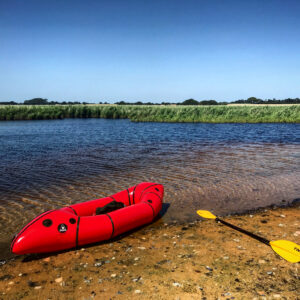What packraft to choose? That’s a difficult question. Over the last two years I have seen a huge increase in the popularity of Packrafts.
Why is this? I think it’s down to people like myself who have been influencing there followers into the wide use of Packrafts.
The YouTube videos of multi day packrafting trips, the hike and paddle of a local river or using your packraft for a days fishing.
To me, packrafting has really opened the doors to adventure, especially during the COVID lockdowns it has allowed me to develop bike and paddle routes in my local area.
But what to choose? There is so many Packrafts on the market now, with many small companies starting up.
In the U.K I have seen massive increase of followers in UK based Facebook groups based on packrafting and many more people are asking questions on my YouTube videos about what packraft to choose.
That’s million dollar question, choosing a Packraft depends on many things. So let’s look at a few.
What packraft to choose:
What do you want to get out of packrafting?
Firstly, let’s think about a few things.
- What are you going to use your packraft for?
- flat water. You might not need a spray deck, but it’s worth thinking about if you’re paddling cold water or in a rainy environment.
- white water. You will need to think about what grade of water you’ll be paddling, spray deck, thigh straps, self bailer (these are holes in the bottom of the raft that allow water ingress to escape by the Venturi effect of the packraft passing over water), helmet and other ancillary items
- distance paddling. Water temperature, water conditions.
- hunting. Terrain your paddling through, weight needed to carry, tie off points
- bikerafting. A specific packraft purposely designed for bikerafting.
- hiking and paddling. Terrain (land and water), cargo fly (for storing gear within the tubes of the packraft)
- fishing. Spray deck (to limit water ingress, fishing table, can the packraft have ancillary gear attachments, i.e rod holders.
- ancillary gear. Cargo fly, bow bags, throw lines, pfd.
The next thing to think about is how much do you have to spend. The one thing I’d like you to take from this article is don’t be caught up by false economy.
There’s loads of Packrafts on the market and some people will look at the price of the packraft first.
What packraft to choose: Types of Packrafts.
There a loads of different types of packrafts: lightweight, white water, self bailing, expedition, bike rafting, hunting to name a few.
I would recommend that you spend some time thinking about what you want out of your packrat before hitting the ‘buy now’ button.
Below is a short comparison of the Packrafts producers I have dealt with.
Aqua-Xtreme
These Packrafts are cheap to buy. These rafts are good if you are a weekend paddler that won’t be testing the durability of a packraft to the extreme. I tested two Packrafts from aqua-extreme (X1 and Alpha).
They both where great on easy paddles but during my packrafting the river Waveney trip the inflation valves both failed in the same way.
The gasket that secures the valve onto the boat came away from the Packraft and air started to leak from the Packraft.
If this was one raft that failed like this I could put it down to a manufacturing issue but as both failed I’ll put it down to a design floor.
Produced in Israel, import tax required.
Aqua Xtreme produce, white water, self bailing, 2 man and general paddling packrafts made from TPU.
Review of the X1. Review of the Alpha
Neris.
Pproduced in the Ukraine. Initially they only produced the heavier PVC rafts but now there is the TPU option on all of their designs.
The pvc rafts are built like tanks, strong and really realise. The issue with pvc rafts is that they are a lot heavier. The BigFun EXP weighs 9kg with the bag and foot pump.
I have setup one of the BigFun EXP specifically for fishing. (Setup shown in this video)
If your setting up straight out of your car then this is an option, I would want to carry this packraft to far.
Neris produce packrafts, for expeditions, white water, general paddling from PVC and TPU.
Available in the UK from NERIS UK.
Review of the Neris BigFun EXP.
Adélie Packrafts. (No longer in business).
Adélie are based in Scotland with there Packrafts produced in China. There are now 2 options of the initial design, called the voyager.
4 sizes which is great at getting a Packraft that is the correct size for you.
The new design incorporates a removable spray skirt.
Well made, lightweight. That great thing about the Adélie design is they come with a removable skeg which really helps to keep the Packraft tracking straight.
Adelie produce general paddling packrafts and white water from TPU.
Alpacka.
Alpacka where basically the first civilian Packrafts available.
A massive choice depending on what you need, with whitewater rafts, rafts made for hunting, self bailing rafts, rafts for bike rafting, lightweight and exceptionally well made.
Due to the years of producing Packrafts, Alpacka are (in my eyes) the market leader. Their Packrafts are not cheap (I wouldn’t say expensive) as you get what you pay for.
My recommendation would be to spend a little more so you don’t get caught up with false economy.
There’s nothing worse that spending £500 on a raft then it leaks and you have to spend more to replace it.
Produced in the States, import tax required if importing to the UK.
You could consider buying from Backcountry Scot within the UK avoiding import tax or Packraft Europe that supplies Alpacka Packrafts and many other items required for packrafting.
Alpacka, being the market leader pretty much build any style of packraft from general use, white water, self bailing, expedition, hunting, 2 man and many more.
What packraft to choose?
Myself, I chose the Alpacka Caribou. I wanted a packraft that was lightweight and big enough to carry loads of gear.
As the Caribou is designed to carry a bike on the bow, the Alpacka Caribou was perfect for loads of adventures.

The model I purchased had the cargo fly installed on the stern.
Cargo Fly or no cargo fly?
When looking at what packraft to choose, there’s a lot talk about how durable and safe cargo fly’s are but after testing the Caribou last year with a cargo fly I realised the potential.
The cargo fly is basically a dry zip on the stern which allows access into the raft. This is helpful for two reasons.
- To store gear inside the tubes of the raft.
- Easy access for repairs.
What the cargo fly means to me is that with an open boat, you can safely store all (or most) of your gear inside the raft, keeping it dry and the weight also helps with the stability of the raft.
Many people aren’t keen on these zip and I can understand why. If the zip fails then that’s the packraft knackered.
As long as the zip is cared for and cleaned the zip will last a long time.
The only down fall with storing gear in the raft is that every time you open the zip you’ll need to reinflate the raft. Thats where a small rechargeable pump comes in handy.
These battery pumps by flextail gear are a great addition. Lightweight, small and can be used to inflate other things like sleep mats. If you’re looking for a bigger more robust pump then have a look at the max boat pump by Flextail Gear. The max boat pump is a great pump but a little heavy. It will inflate your packraft completely (20 times on one charge).
Review of the Alpacka Caribou.
Whatever packraft you choose i’m sure like many others you’ll get massively hooked and it will open up so many doors to adventure.
Here is some links to a couple of Facebook groups for packrafting.














2 thoughts on “What Packraft to choose? Alpacka? Neris? Anfibio?”